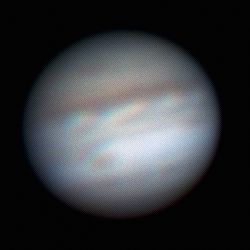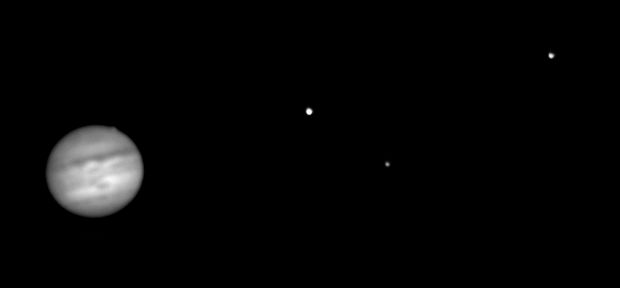

 |
This is my first attempt at RGB imaging of a planet. The advantage is that I use my raw-modified Atik camera which is more sensitive and may have a better resolution than my Toucam. The disadvantage is that it took me ten minutes to collect all the images from which the composite is made and Jupiter rotates so quickly that the features may have moved noticeably in that time. The indistinct spot just south of the equator (seen more clearly in the picture below) is the Great Red Spot. Date and Time: 7th July 2007 22:19 to 22:29 UT Camera: Raw-modified Atik 1HS Telescope: LX200 at prime focus Capture: K3CCDTools. Low gamma, 1/33", 1/50", 1/25" (R,G,B) 56% - 70 gain, >600 frames Processing: Registax. 183(R) 300(G,B) frames stacked. Wavelets 1-3 = 10, sigmoid gamma |
 |
This is a composite of two pictures, one exposed for the satellites and one for the planet. Move your mouse over the image to see the satellites identified, but can you see Ganymede? It was just emerging from transit and shows as a tiny bump on the limb of Jupiter. Its shadow appeared about an hour later but by that time Jupiter had moved behind a neighbour's tree. The Great Red Spot is the dark spot just south of the equator almost in the centre of the disc. See how much it has moved in the half hour between this and the picture above. Date and Time: 7th July 2007 22:56-58 UT Camera: Raw-modified Atik 1HS Telescope: LX200 at prime focus with Astronomik green filter. Capture: K3CCDTools. Low gamma (planet), high gamma (sats), 1/33" & 9% gain (planet), 1/25" & 51% gain (sats) , 300 frames Processing: Registax. Planet 224 frames stacked. Wavelet 1-3 = 10, histogram 0-215 Satellites 311 frames stacked, wavelets 1-2 =10, histogram 0-180 |